CHCECE006 & CHCECE011: Supporting Child Behaviour & Play Project
VerifiedAdded on 2023/06/18
|11
|2115
|285
Project
AI Summary
This assignment consists of two projects related to early childhood education and care. The first project (CHCECE006) focuses on supporting the behavior of children and young people, specifically addressing Oppositional Defiant Disorder (ODD). It includes a detailed description of ODD, environmental adjustments, safe practices, behavior expectations, communication strategies, positive reinforcement, redirection techniques, and a personalized behavior support plan. It also identifies specialists who can contribute to the support of children with ODD. The second project (CHCECE011) emphasizes the importance of play in children's development and how education and care services can design environments and programs to meet individual needs, cultural diversity, safety, and learning objectives. It explains the principles of the National Quality Framework (NQF), the National Quality Standards (NQS), and the Early Years Learning Framework (EYLF). The assignment provides insights into meeting children's cultural, gender, and safety requirements, guiding their behavior, communicating rules, acknowledging positive behaviors, and fostering their interests and learning.

Cert III Early Childhood Education and Care
CHCECE006 - Support behaviour of children and young
people
CHCECE011 - Provide experiences to support children’s
play and learning
Project 1
By
Name Date Page 1
CHCECE006 - Support behaviour of children and young
people
CHCECE011 - Provide experiences to support children’s
play and learning
Project 1
By
Name Date Page 1
Paraphrase This Document
Need a fresh take? Get an instant paraphrase of this document with our AI Paraphraser
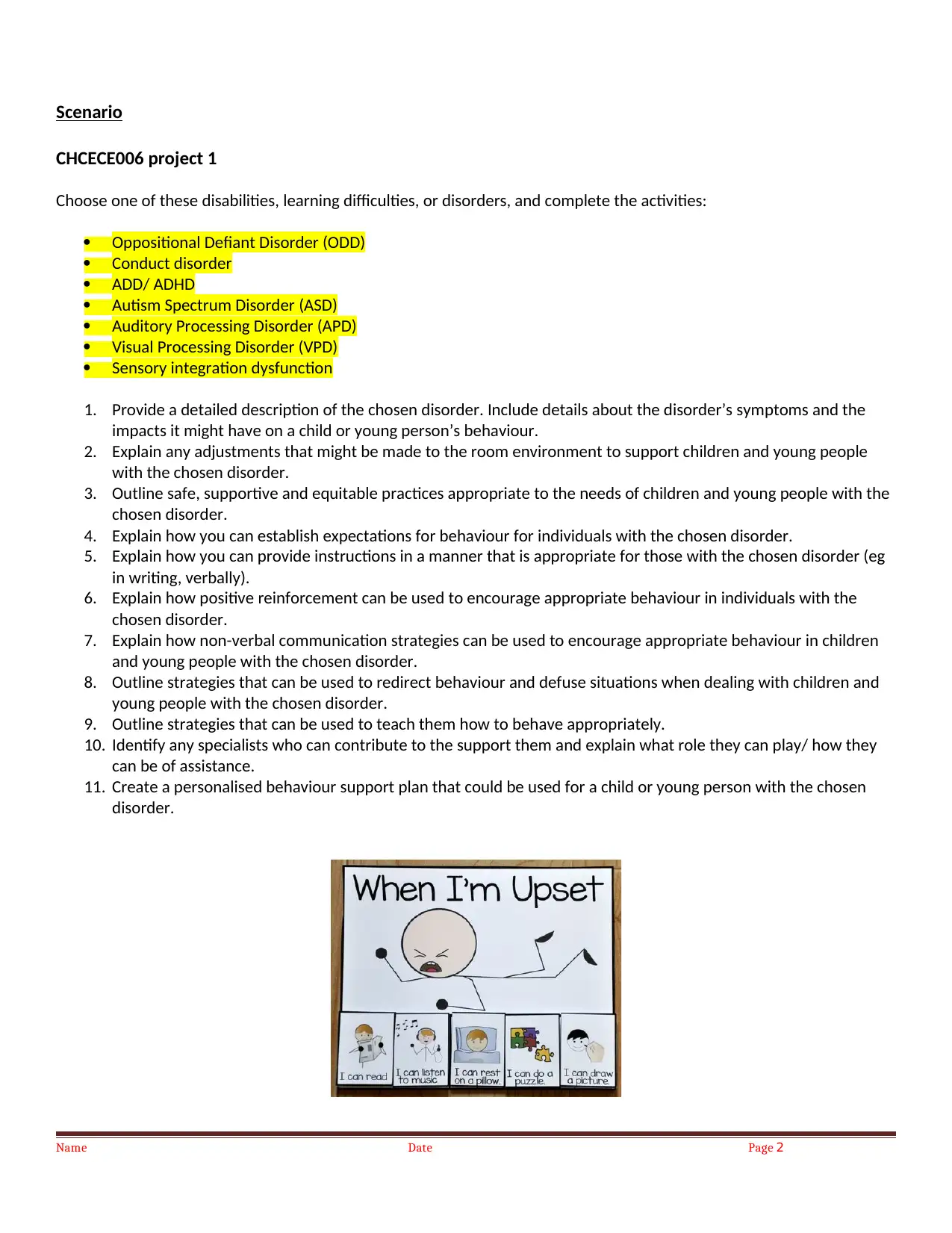
Scenario
CHCECE006 project 1
Choose one of these disabilities, learning difficulties, or disorders, and complete the activities:
Oppositional Defiant Disorder (ODD)
Conduct disorder
ADD/ ADHD
Autism Spectrum Disorder (ASD)
Auditory Processing Disorder (APD)
Visual Processing Disorder (VPD)
Sensory integration dysfunction
1. Provide a detailed description of the chosen disorder. Include details about the disorder’s symptoms and the
impacts it might have on a child or young person’s behaviour.
2. Explain any adjustments that might be made to the room environment to support children and young people
with the chosen disorder.
3. Outline safe, supportive and equitable practices appropriate to the needs of children and young people with the
chosen disorder.
4. Explain how you can establish expectations for behaviour for individuals with the chosen disorder.
5. Explain how you can provide instructions in a manner that is appropriate for those with the chosen disorder (eg
in writing, verbally).
6. Explain how positive reinforcement can be used to encourage appropriate behaviour in individuals with the
chosen disorder.
7. Explain how non-verbal communication strategies can be used to encourage appropriate behaviour in children
and young people with the chosen disorder.
8. Outline strategies that can be used to redirect behaviour and defuse situations when dealing with children and
young people with the chosen disorder.
9. Outline strategies that can be used to teach them how to behave appropriately.
10. Identify any specialists who can contribute to the support them and explain what role they can play/ how they
can be of assistance.
11. Create a personalised behaviour support plan that could be used for a child or young person with the chosen
disorder.
Name Date Page 2
CHCECE006 project 1
Choose one of these disabilities, learning difficulties, or disorders, and complete the activities:
Oppositional Defiant Disorder (ODD)
Conduct disorder
ADD/ ADHD
Autism Spectrum Disorder (ASD)
Auditory Processing Disorder (APD)
Visual Processing Disorder (VPD)
Sensory integration dysfunction
1. Provide a detailed description of the chosen disorder. Include details about the disorder’s symptoms and the
impacts it might have on a child or young person’s behaviour.
2. Explain any adjustments that might be made to the room environment to support children and young people
with the chosen disorder.
3. Outline safe, supportive and equitable practices appropriate to the needs of children and young people with the
chosen disorder.
4. Explain how you can establish expectations for behaviour for individuals with the chosen disorder.
5. Explain how you can provide instructions in a manner that is appropriate for those with the chosen disorder (eg
in writing, verbally).
6. Explain how positive reinforcement can be used to encourage appropriate behaviour in individuals with the
chosen disorder.
7. Explain how non-verbal communication strategies can be used to encourage appropriate behaviour in children
and young people with the chosen disorder.
8. Outline strategies that can be used to redirect behaviour and defuse situations when dealing with children and
young people with the chosen disorder.
9. Outline strategies that can be used to teach them how to behave appropriately.
10. Identify any specialists who can contribute to the support them and explain what role they can play/ how they
can be of assistance.
11. Create a personalised behaviour support plan that could be used for a child or young person with the chosen
disorder.
Name Date Page 2
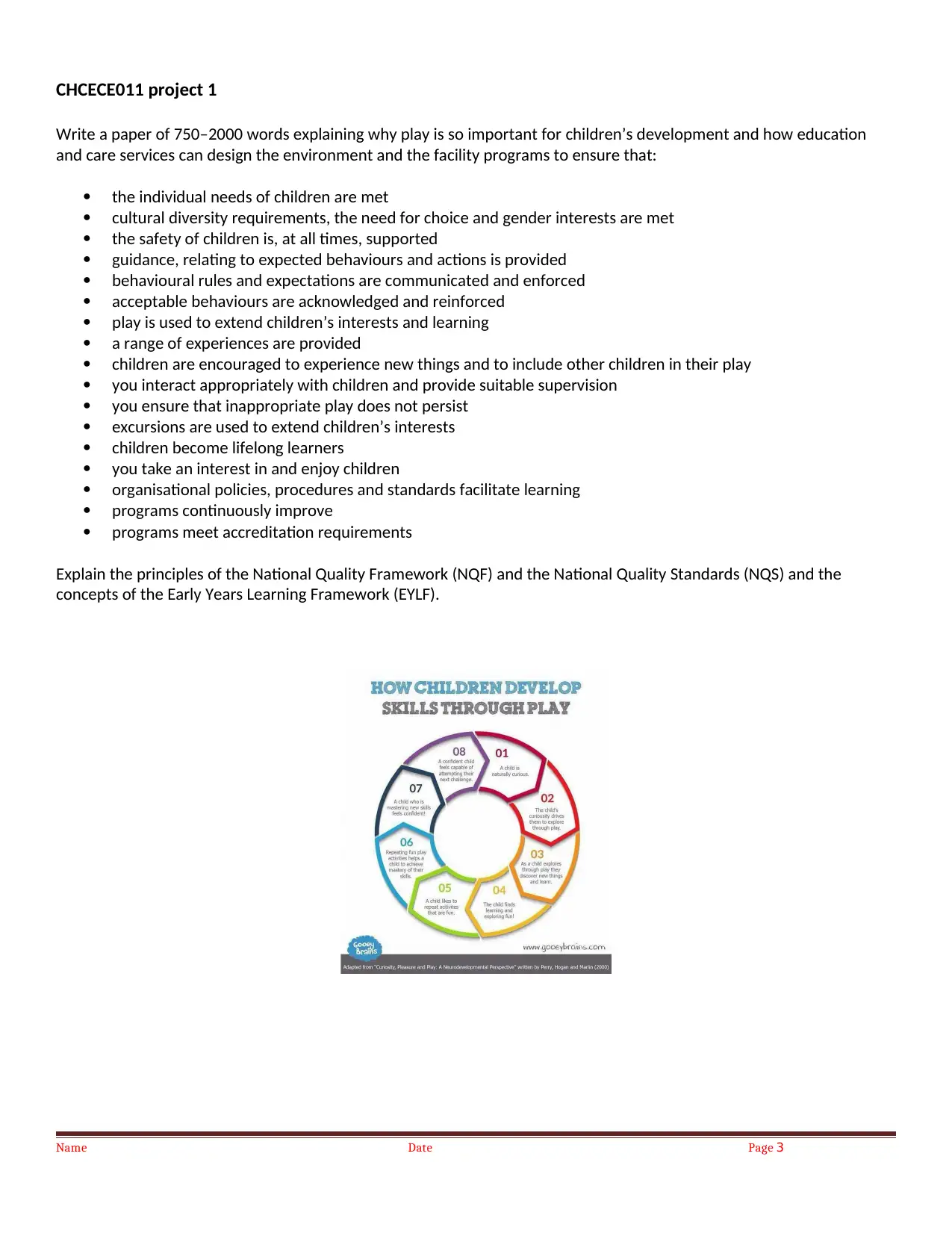
CHCECE011 project 1
Write a paper of 750–2000 words explaining why play is so important for children’s development and how education
and care services can design the environment and the facility programs to ensure that:
the individual needs of children are met
cultural diversity requirements, the need for choice and gender interests are met
the safety of children is, at all times, supported
guidance, relating to expected behaviours and actions is provided
behavioural rules and expectations are communicated and enforced
acceptable behaviours are acknowledged and reinforced
play is used to extend children’s interests and learning
a range of experiences are provided
children are encouraged to experience new things and to include other children in their play
you interact appropriately with children and provide suitable supervision
you ensure that inappropriate play does not persist
excursions are used to extend children’s interests
children become lifelong learners
you take an interest in and enjoy children
organisational policies, procedures and standards facilitate learning
programs continuously improve
programs meet accreditation requirements
Explain the principles of the National Quality Framework (NQF) and the National Quality Standards (NQS) and the
concepts of the Early Years Learning Framework (EYLF).
Name Date Page 3
Write a paper of 750–2000 words explaining why play is so important for children’s development and how education
and care services can design the environment and the facility programs to ensure that:
the individual needs of children are met
cultural diversity requirements, the need for choice and gender interests are met
the safety of children is, at all times, supported
guidance, relating to expected behaviours and actions is provided
behavioural rules and expectations are communicated and enforced
acceptable behaviours are acknowledged and reinforced
play is used to extend children’s interests and learning
a range of experiences are provided
children are encouraged to experience new things and to include other children in their play
you interact appropriately with children and provide suitable supervision
you ensure that inappropriate play does not persist
excursions are used to extend children’s interests
children become lifelong learners
you take an interest in and enjoy children
organisational policies, procedures and standards facilitate learning
programs continuously improve
programs meet accreditation requirements
Explain the principles of the National Quality Framework (NQF) and the National Quality Standards (NQS) and the
concepts of the Early Years Learning Framework (EYLF).
Name Date Page 3
⊘ This is a preview!⊘
Do you want full access?
Subscribe today to unlock all pages.

Trusted by 1+ million students worldwide
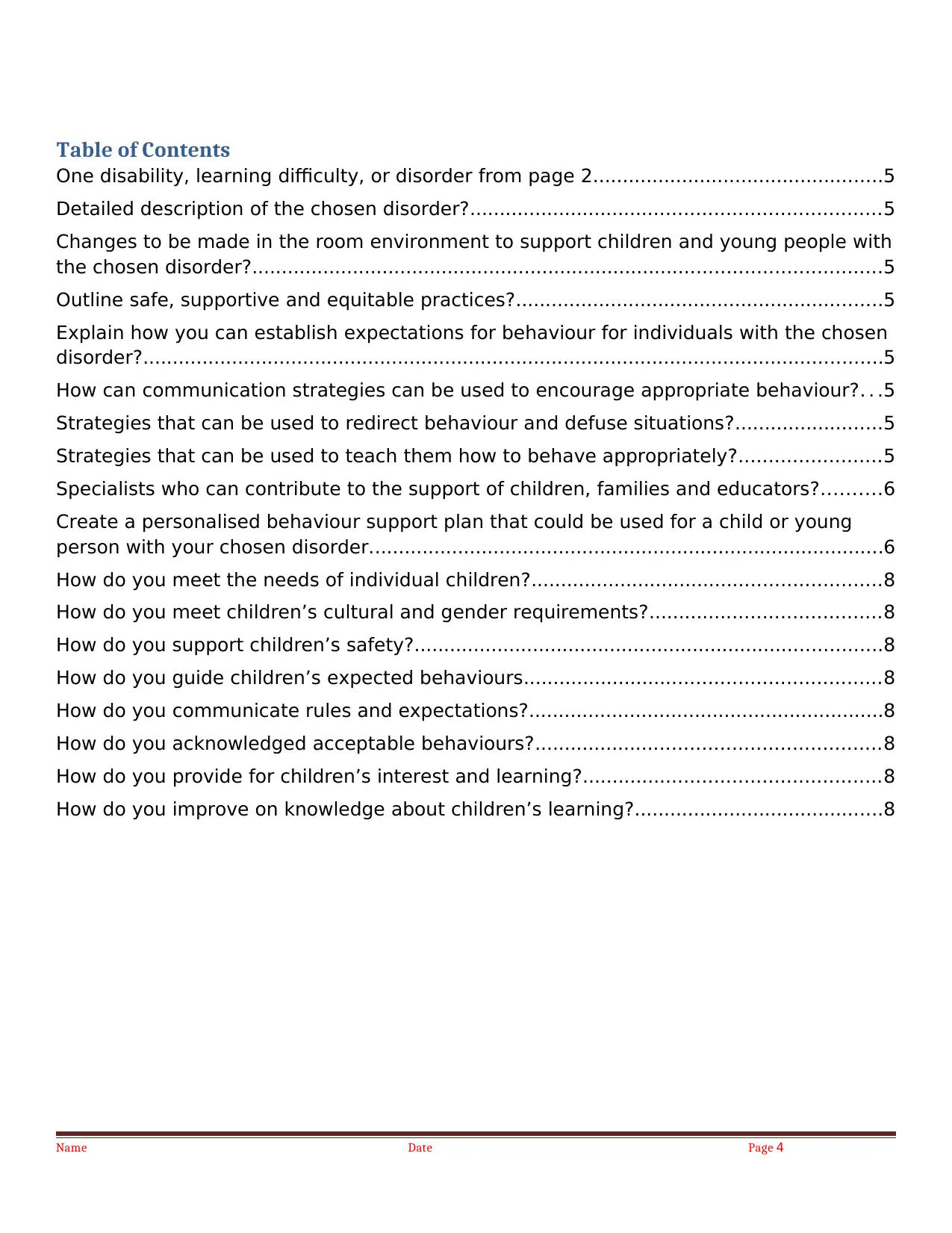
Table of Contents
One disability, learning difficulty, or disorder from page 2.................................................5
Detailed description of the chosen disorder?.....................................................................5
Changes to be made in the room environment to support children and young people with
the chosen disorder?..........................................................................................................5
Outline safe, supportive and equitable practices?..............................................................5
Explain how you can establish expectations for behaviour for individuals with the chosen
disorder?.............................................................................................................................5
How can communication strategies can be used to encourage appropriate behaviour?. . .5
Strategies that can be used to redirect behaviour and defuse situations?.........................5
Strategies that can be used to teach them how to behave appropriately?........................5
Specialists who can contribute to the support of children, families and educators?..........6
Create a personalised behaviour support plan that could be used for a child or young
person with your chosen disorder.......................................................................................6
How do you meet the needs of individual children?...........................................................8
How do you meet children’s cultural and gender requirements?.......................................8
How do you support children’s safety?...............................................................................8
How do you guide children’s expected behaviours............................................................8
How do you communicate rules and expectations?............................................................8
How do you acknowledged acceptable behaviours?..........................................................8
How do you provide for children’s interest and learning?..................................................8
How do you improve on knowledge about children’s learning?..........................................8
Name Date Page 4
One disability, learning difficulty, or disorder from page 2.................................................5
Detailed description of the chosen disorder?.....................................................................5
Changes to be made in the room environment to support children and young people with
the chosen disorder?..........................................................................................................5
Outline safe, supportive and equitable practices?..............................................................5
Explain how you can establish expectations for behaviour for individuals with the chosen
disorder?.............................................................................................................................5
How can communication strategies can be used to encourage appropriate behaviour?. . .5
Strategies that can be used to redirect behaviour and defuse situations?.........................5
Strategies that can be used to teach them how to behave appropriately?........................5
Specialists who can contribute to the support of children, families and educators?..........6
Create a personalised behaviour support plan that could be used for a child or young
person with your chosen disorder.......................................................................................6
How do you meet the needs of individual children?...........................................................8
How do you meet children’s cultural and gender requirements?.......................................8
How do you support children’s safety?...............................................................................8
How do you guide children’s expected behaviours............................................................8
How do you communicate rules and expectations?............................................................8
How do you acknowledged acceptable behaviours?..........................................................8
How do you provide for children’s interest and learning?..................................................8
How do you improve on knowledge about children’s learning?..........................................8
Name Date Page 4
Paraphrase This Document
Need a fresh take? Get an instant paraphrase of this document with our AI Paraphraser
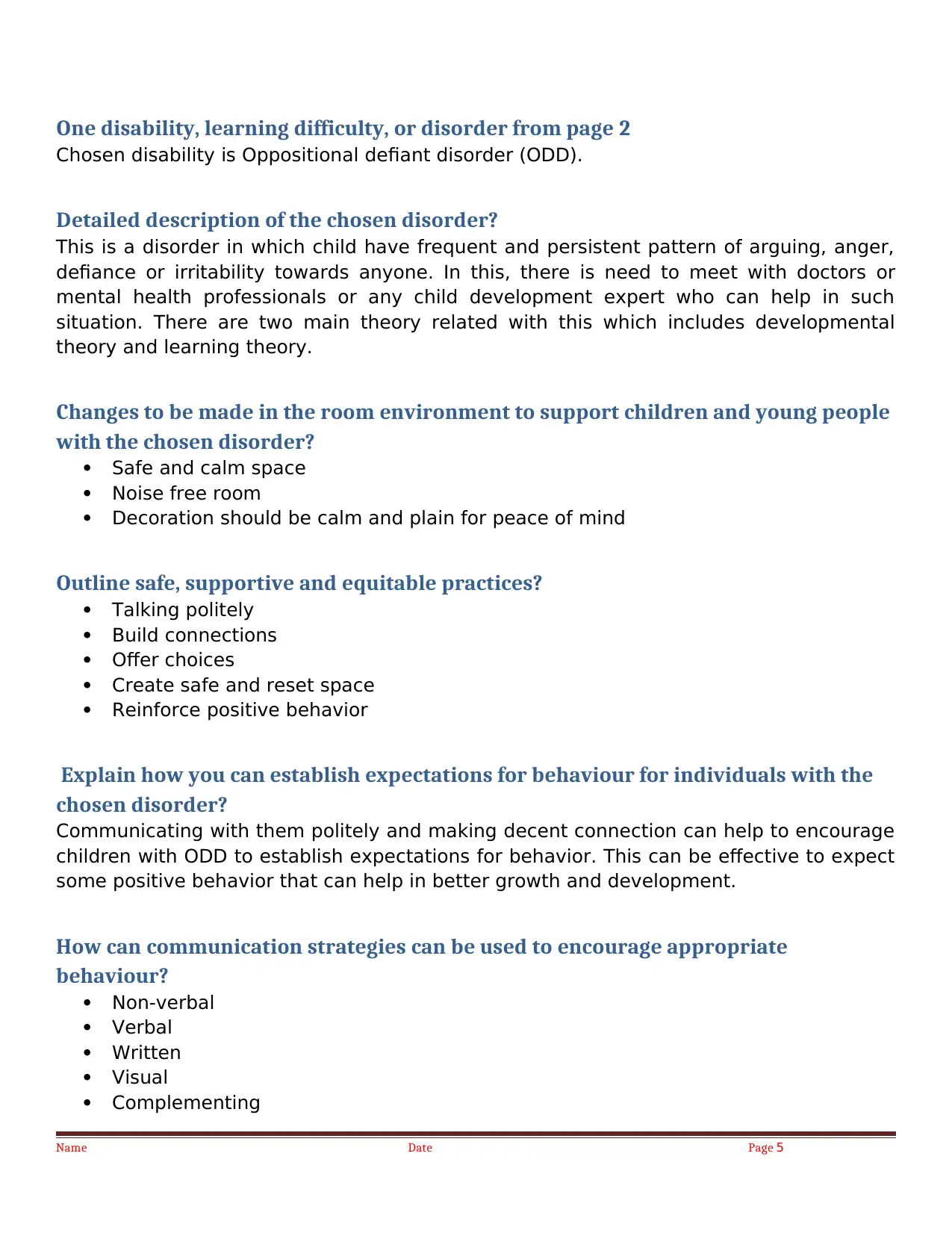
One disability, learning difficulty, or disorder from page 2
Chosen disability is Oppositional defiant disorder (ODD).
Detailed description of the chosen disorder?
This is a disorder in which child have frequent and persistent pattern of arguing, anger,
defiance or irritability towards anyone. In this, there is need to meet with doctors or
mental health professionals or any child development expert who can help in such
situation. There are two main theory related with this which includes developmental
theory and learning theory.
Changes to be made in the room environment to support children and young people
with the chosen disorder?
Safe and calm space
Noise free room
Decoration should be calm and plain for peace of mind
Outline safe, supportive and equitable practices?
Talking politely
Build connections
Offer choices
Create safe and reset space
Reinforce positive behavior
Explain how you can establish expectations for behaviour for individuals with the
chosen disorder?
Communicating with them politely and making decent connection can help to encourage
children with ODD to establish expectations for behavior. This can be effective to expect
some positive behavior that can help in better growth and development.
How can communication strategies can be used to encourage appropriate
behaviour?
Non-verbal
Verbal
Written
Visual
Complementing
Name Date Page 5
Chosen disability is Oppositional defiant disorder (ODD).
Detailed description of the chosen disorder?
This is a disorder in which child have frequent and persistent pattern of arguing, anger,
defiance or irritability towards anyone. In this, there is need to meet with doctors or
mental health professionals or any child development expert who can help in such
situation. There are two main theory related with this which includes developmental
theory and learning theory.
Changes to be made in the room environment to support children and young people
with the chosen disorder?
Safe and calm space
Noise free room
Decoration should be calm and plain for peace of mind
Outline safe, supportive and equitable practices?
Talking politely
Build connections
Offer choices
Create safe and reset space
Reinforce positive behavior
Explain how you can establish expectations for behaviour for individuals with the
chosen disorder?
Communicating with them politely and making decent connection can help to encourage
children with ODD to establish expectations for behavior. This can be effective to expect
some positive behavior that can help in better growth and development.
How can communication strategies can be used to encourage appropriate
behaviour?
Non-verbal
Verbal
Written
Visual
Complementing
Name Date Page 5
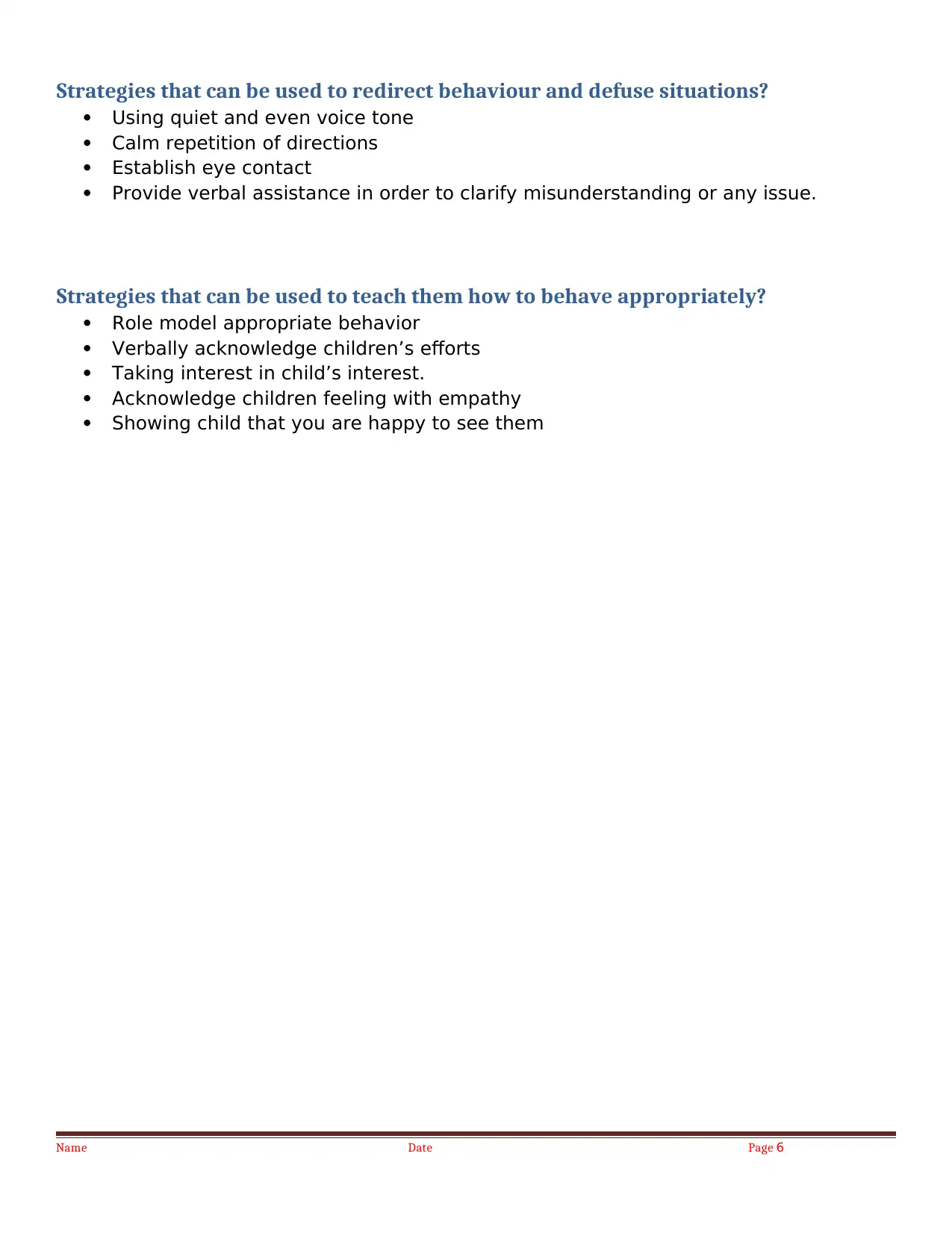
Strategies that can be used to redirect behaviour and defuse situations?
Using quiet and even voice tone
Calm repetition of directions
Establish eye contact
Provide verbal assistance in order to clarify misunderstanding or any issue.
Strategies that can be used to teach them how to behave appropriately?
Role model appropriate behavior
Verbally acknowledge children’s efforts
Taking interest in child’s interest.
Acknowledge children feeling with empathy
Showing child that you are happy to see them
Name Date Page 6
Using quiet and even voice tone
Calm repetition of directions
Establish eye contact
Provide verbal assistance in order to clarify misunderstanding or any issue.
Strategies that can be used to teach them how to behave appropriately?
Role model appropriate behavior
Verbally acknowledge children’s efforts
Taking interest in child’s interest.
Acknowledge children feeling with empathy
Showing child that you are happy to see them
Name Date Page 6
⊘ This is a preview!⊘
Do you want full access?
Subscribe today to unlock all pages.

Trusted by 1+ million students worldwide
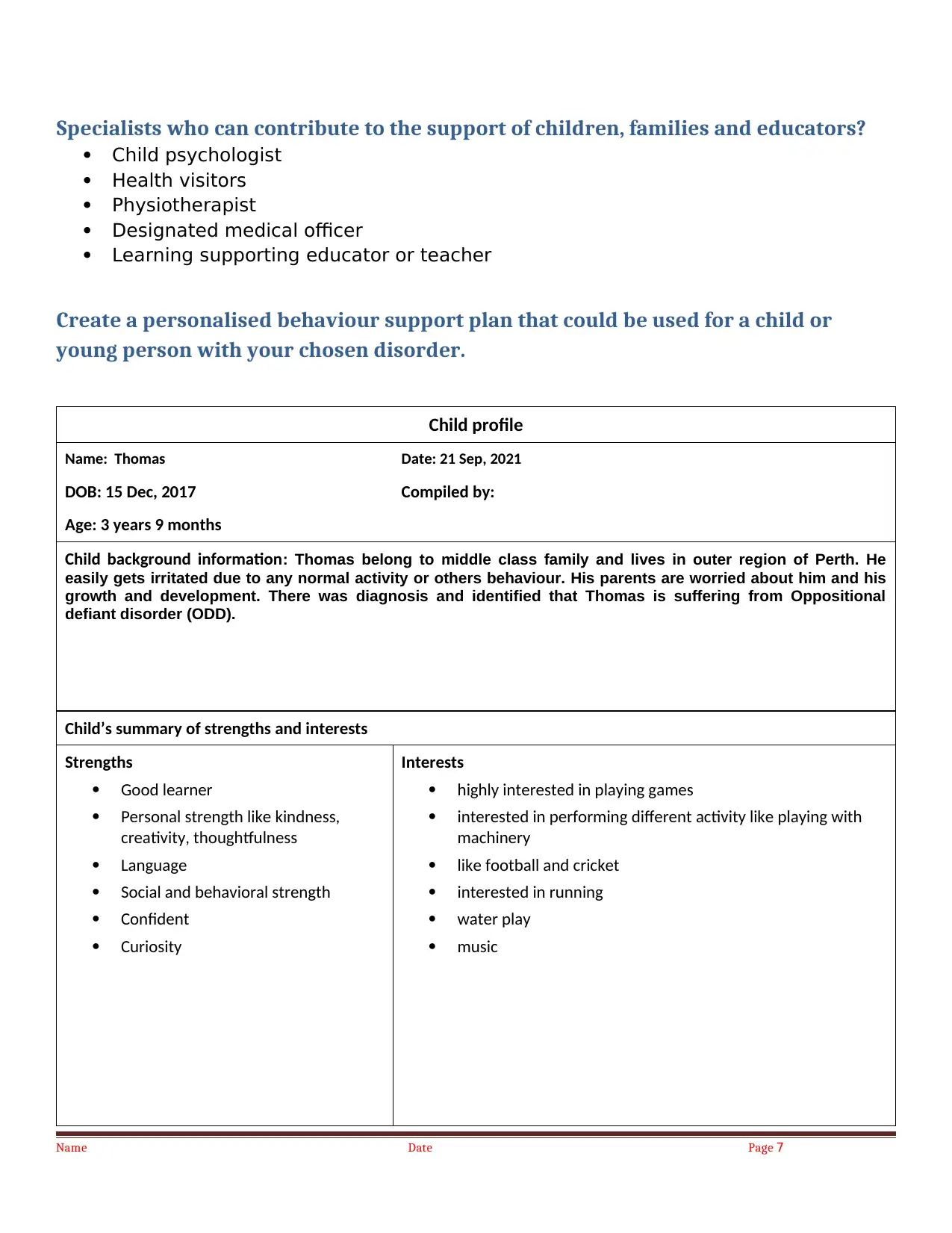
Specialists who can contribute to the support of children, families and educators?
Child psychologist
Health visitors
Physiotherapist
Designated medical officer
Learning supporting educator or teacher
Create a personalised behaviour support plan that could be used for a child or
young person with your chosen disorder.
Child profile
Name: Thomas Date: 21 Sep, 2021
DOB: 15 Dec, 2017 Compiled by:
Age: 3 years 9 months
Child background information: Thomas belong to middle class family and lives in outer region of Perth. He
easily gets irritated due to any normal activity or others behaviour. His parents are worried about him and his
growth and development. There was diagnosis and identified that Thomas is suffering from Oppositional
defiant disorder (ODD).
Child’s summary of strengths and interests
Strengths
Good learner
Personal strength like kindness,
creativity, thoughtfulness
Language
Social and behavioral strength
Confident
Curiosity
Interests
highly interested in playing games
interested in performing different activity like playing with
machinery
like football and cricket
interested in running
water play
music
Name Date Page 7
Child psychologist
Health visitors
Physiotherapist
Designated medical officer
Learning supporting educator or teacher
Create a personalised behaviour support plan that could be used for a child or
young person with your chosen disorder.
Child profile
Name: Thomas Date: 21 Sep, 2021
DOB: 15 Dec, 2017 Compiled by:
Age: 3 years 9 months
Child background information: Thomas belong to middle class family and lives in outer region of Perth. He
easily gets irritated due to any normal activity or others behaviour. His parents are worried about him and his
growth and development. There was diagnosis and identified that Thomas is suffering from Oppositional
defiant disorder (ODD).
Child’s summary of strengths and interests
Strengths
Good learner
Personal strength like kindness,
creativity, thoughtfulness
Language
Social and behavioral strength
Confident
Curiosity
Interests
highly interested in playing games
interested in performing different activity like playing with
machinery
like football and cricket
interested in running
water play
music
Name Date Page 7
Paraphrase This Document
Need a fresh take? Get an instant paraphrase of this document with our AI Paraphraser

Assessment of needs
Thomas parents are observing Thomas behavior which are not common for his age. They have observed some change in the
behavior which was not good and positive. There was observation about change in behavior which was regarding getting easily
angry, irritated. There was also observation of argumentative and defiant behavior. Due to such type of behavior there is need for
the assessment of Thomas.
Name Date Page 8
Thomas parents are observing Thomas behavior which are not common for his age. They have observed some change in the
behavior which was not good and positive. There was observation about change in behavior which was regarding getting easily
angry, irritated. There was also observation of argumentative and defiant behavior. Due to such type of behavior there is need for
the assessment of Thomas.
Name Date Page 8

Child’s long Term Goal
They should respond to diversity with respect where they learn to respond to different people with respect.
Link to ELYF:
Child’s short Term Goal 1
To act effectively with different cultural people and to diverse people.
Link to ELYF:
Strategies:
There is need to focus on the delivery better education and learning about diversity and to meet and talk with
different people with different diversity.
Proper education and learning to respect different culture can be effective to achieve short term goal and long
term goal.
Will the plan be discussed with the child? No Yes
Discussion with other educators. (How will other educators support the Behaviour Plan?
Other educator should help to getting learning about the behavior plan where they can influence Thomas to
learn about different culture. In this, educator should work collaboratively to focus on the delivery of better
education and learning to children.
How does the plan reflect the services philosophy, policies, procedures and relevant cultural practices?
(Review services Behavior Management Policy)
Behavior plan should reflect the services which includes philosophy that can have impact on children thinking. Here, it
is need to follow the policy and procedure related with relevant cultural practices that can impact children to get
education.
Date to commence:
Date of first review meeting:
Date of second review meeting:
Name Date Page 9
They should respond to diversity with respect where they learn to respond to different people with respect.
Link to ELYF:
Child’s short Term Goal 1
To act effectively with different cultural people and to diverse people.
Link to ELYF:
Strategies:
There is need to focus on the delivery better education and learning about diversity and to meet and talk with
different people with different diversity.
Proper education and learning to respect different culture can be effective to achieve short term goal and long
term goal.
Will the plan be discussed with the child? No Yes
Discussion with other educators. (How will other educators support the Behaviour Plan?
Other educator should help to getting learning about the behavior plan where they can influence Thomas to
learn about different culture. In this, educator should work collaboratively to focus on the delivery of better
education and learning to children.
How does the plan reflect the services philosophy, policies, procedures and relevant cultural practices?
(Review services Behavior Management Policy)
Behavior plan should reflect the services which includes philosophy that can have impact on children thinking. Here, it
is need to follow the policy and procedure related with relevant cultural practices that can impact children to get
education.
Date to commence:
Date of first review meeting:
Date of second review meeting:
Name Date Page 9
⊘ This is a preview!⊘
Do you want full access?
Subscribe today to unlock all pages.

Trusted by 1+ million students worldwide

CHCECE011 project 1
How do you meet the needs of individual children?
By proper focusing on the individual need and effectively fulfilling those need in order to
proper growth and development. There is also need to ensure about the safety needs
along with interests.
How do you meet children’s cultural and gender requirements?
Through providing education and learning about the different culture can help to meet
the cultural requirement. Gender requirements can be fulfilled through the providing
learning and providing knowledge related with gender.
How do you support children’s safety?
Providing knowledge and learning about the safety concern and educating children about
the safety can help to support children’s safety. Safeguarding is also helpful in
supporting children.
How do you guide children’s expected behaviours
There is need to follow some rules which should be simple and convenient. Talking with
children also allow to guide children expectation behaviors. There is also need to show
respect to children can also help in guide children expected behaviors.
How do you communicate rules and expectations?
There is need to be specific about the expectation from children and the other things
which is expected to do. There is need to enable them to understand about the rules
which can help to ensure about the safety and getting effective education.
How do you acknowledged acceptable behaviours?
Giving positive response to the behavior which is desired along with avoid responding
when expected behavior is not occurring. In this, there is need to tell child what should
be done right or wrong.
How do you provide for children’s interest and learning?
Let children know that educator belief in them can help to create interest and learning.
This can also help through providing the positive attitude for school and learning.
Name Date Page 10
How do you meet the needs of individual children?
By proper focusing on the individual need and effectively fulfilling those need in order to
proper growth and development. There is also need to ensure about the safety needs
along with interests.
How do you meet children’s cultural and gender requirements?
Through providing education and learning about the different culture can help to meet
the cultural requirement. Gender requirements can be fulfilled through the providing
learning and providing knowledge related with gender.
How do you support children’s safety?
Providing knowledge and learning about the safety concern and educating children about
the safety can help to support children’s safety. Safeguarding is also helpful in
supporting children.
How do you guide children’s expected behaviours
There is need to follow some rules which should be simple and convenient. Talking with
children also allow to guide children expectation behaviors. There is also need to show
respect to children can also help in guide children expected behaviors.
How do you communicate rules and expectations?
There is need to be specific about the expectation from children and the other things
which is expected to do. There is need to enable them to understand about the rules
which can help to ensure about the safety and getting effective education.
How do you acknowledged acceptable behaviours?
Giving positive response to the behavior which is desired along with avoid responding
when expected behavior is not occurring. In this, there is need to tell child what should
be done right or wrong.
How do you provide for children’s interest and learning?
Let children know that educator belief in them can help to create interest and learning.
This can also help through providing the positive attitude for school and learning.
Name Date Page 10
Paraphrase This Document
Need a fresh take? Get an instant paraphrase of this document with our AI Paraphraser
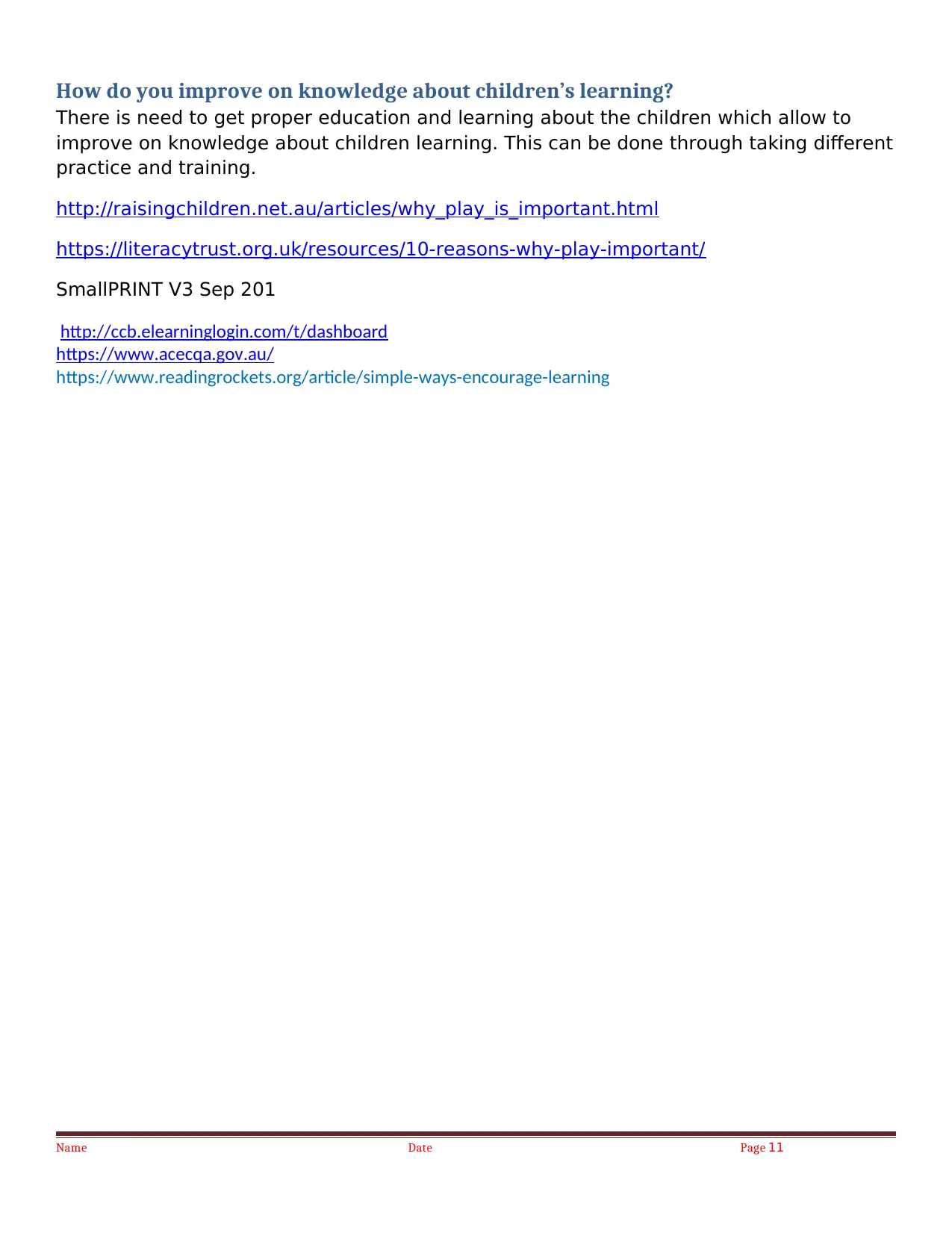
How do you improve on knowledge about children’s learning?
There is need to get proper education and learning about the children which allow to
improve on knowledge about children learning. This can be done through taking different
practice and training.
http://raisingchildren.net.au/articles/why_play_is_important.html
https://literacytrust.org.uk/resources/10-reasons-why-play-important/
SmallPRINT V3 Sep 201
http://ccb.elearninglogin.com/t/dashboard
https://www.acecqa.gov.au/
https://www.readingrockets.org/article/simple-ways-encourage-learning
Name Date Page 11
There is need to get proper education and learning about the children which allow to
improve on knowledge about children learning. This can be done through taking different
practice and training.
http://raisingchildren.net.au/articles/why_play_is_important.html
https://literacytrust.org.uk/resources/10-reasons-why-play-important/
SmallPRINT V3 Sep 201
http://ccb.elearninglogin.com/t/dashboard
https://www.acecqa.gov.au/
https://www.readingrockets.org/article/simple-ways-encourage-learning
Name Date Page 11
1 out of 11
Related Documents
Your All-in-One AI-Powered Toolkit for Academic Success.
+13062052269
info@desklib.com
Available 24*7 on WhatsApp / Email
![[object Object]](/_next/static/media/star-bottom.7253800d.svg)
Unlock your academic potential
Copyright © 2020–2025 A2Z Services. All Rights Reserved. Developed and managed by ZUCOL.




